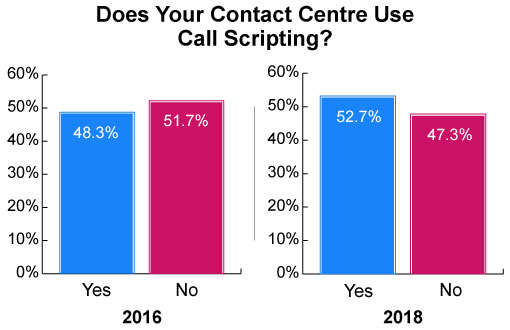Call scripting is used in around half of all contact centres. Get it right and nobody would know that their call is being guided. Get it wrong and the call can sound stilted.
So how can we develop the best script for a contact centre? Here’s our guide to getting the structure and language of your customer service script just right.
Why Use Customer Service Scripts?
The case for not using scripts is that the contact centre wants to empower advisors to think for themselves and engage further with their role. There is also the argument that a script may cause advisors to speak with a stereotypically “robotic” tone, which customers despise.
However, contact centre scripts are becoming more and more sophisticated in terms of structure and writing style. Now, a good script will likely go unnoticed and will save resources in terms of advisor training, while tools can be applied to further engage advisors.
It is perhaps because of these reasons that in the two years from 2016 to 2018, the percentage of contact centres using scripts rose from 48.3% to 52.7%, according to our survey.

The data used in these charts is from our survey: What Contact Centres Are Doing Right Now (2018 Edition)
However, creating a “good” script is easier said than done. To help get you started, it’s important to follow the advice below.
Start by Matching Customer Needs Against Solutions
The starting point for any script is to consider all possible queries that customers might ask and pair them with solutions. Maybe just one solution is required for each query, but consider whether multiple answers are needed for different types of customers.
As Carl Adkins, Founder of Infinity CCS, says: “Design a matrix of customer needs against possible solutions. Then map the foundation of the intended customer interaction and make sure that every iteration is covered.”
“In my experience, some flip-chart paper and Blu Tack is ideal here because it’s quick and visual.”
“Focus efforts on the big box (macro) processes here rather than the detail of the script. That gets added later.”

Design a matrix of customer needs against possible solutions. Then map the foundation of the intended customer interaction.
Using this process will enable you to find the basic bits of information that need to be included in your script. But you also need to consider the thought pattern of the customer who is phoning in. What emotions will they be feeling?
Carl adds: “The best script must consider the customer’s journey; it’s not the customer’s job to adapt to your systems or processes. This is important if you want to build empathy.”
“Your script should allow for an appropriate response to any given customer interaction and prompt the call centre communicator to stay consistent with the company message.”
Only when this is done can you start to consider the structure and language of your script, for which you need to keep the following things in mind.
Click here to find out the Do’s and Don’ts of Call Scripting.
Five Key Script Considerations
According to Kevin Ellis, the former CEO of CallScripter, you need to consider the basic flow and set the objectives of a script before you begin to put everything together.
Kevin suggests that you can do this by breaking the process down into five key areas:
1. Objectives – The main objective of the script has to be decided on before anything else can be considered. Key factors to bear in mind include:
- Who will the advisor be talking to?
- What is likely to be their thought pattern when making or receiving a call?
- What is the key outcome required? (i.e. to generate fundraising, to raise awareness, to develop future selling opportunities?)
2. “Data in” – The data feeding into the script should always be available in a user-friendly format. Determine how much information is needed by the advisor, as well as what data might need to be reported on.
Are they going to be new users who may need a lot of guidance? Or experienced sellers who will be able to tackle the task in hand with no additional information?
3. Advisor ability – You must consider the skills that the advisors involved in your project are going to have. Are they going to be new users who may need a lot of guidance? Or experienced sellers who will be able to tackle the task in hand with no additional information? If it is the latter, then the script is likely to be more straightforward, with fewer operator notes.
4. Advisor information – What do your advisors need to know? Working through a script is a challenging experience – reading, talking and listening all at the same time. A well-thought-out script will aid this process and allow the advisor to focus on the most important communication or selling techniques.
5. “Data out” – Which reports and/or analysis will be required from the outcome of the script? These should be determined from both a company and a customer viewpoint.
Read this Article for 16 Mistakes to Avoid with Call Scripting.
How Should I Structure My Customer Service Script?
Now we have designed solutions to customers’ queries, we can carry these five considerations forwards and begin to think about how we want our script to look.
Here are a few quick tips to help you on your way.
Make It Quick to Read
Use font, colour, graphics and layout options to create emphasis, utilising different styles to highlight what’s most important for the user, as Carl Adkins recommends.
Carl also suggests that we “write the script in short paragraphs that can be read quickly. Include bullet points so that the advisor can hit all the important facts without reading a word-for-word response to the customer.”
Remember, the script is primarily there to create a framework for the conversation, not for advisors to follow word for word – so highlight key parts of information.
Create Flowcharts
Your script needs to be user friendly and efficient, and it must flow. With this in mind, it is great to plan a script layout in flowcharts, which could also be included in the script itself.
Kevin Ellis says: “When preparing a simple script plan, it is important to make sure that your script is fluent so that your advisors can move through the stages swiftly. This keeps your call durations as low as possible, but at the same time guaranteeing that your callers finish the conversation satisfied.”
“Flowcharts provide a pictorial view of the script pages and fluency, and are easily amended to include or remove pages.”

Flowcharts provide a pictorial view of the script pages and fluency, and are easily amended to include or remove pages.
Most scripts are now created using visual flows, with 42.4% of contact centres now including this technology in their advisors’ desktops, as reported in our survey. This technology helps to guide the advisor through the script as they speak.
Build in FAQs
Many of the best solutions to customer queries are lying in your FAQ page, making it a very useful resource to embed into your script.
Carl recommends that you “focus on identifying and refreshing FAQs to identify and answer repeat questions. Do this frequently and thoroughly at the start of campaigns to boost overall effectiveness.”
“If you use call recording, listen to some actual interactions using the script to identify improvements based on the way the customers have responded.”
Apply Auto-Cognitive Tricks
How you structure and present your script can have a big influence on advisor performance, and this is why Kevin suggests using auto-cognitive tricks in your script.
Kevin explains: “A bright, eye-catching script will keep your advisors focused and prevent their attention from wandering.”
“If you’re an outsourcer, your advisors are likely to be working for multiple clients and companies, so it is a good idea to have each company’s corporate colours and signature trademarks on their individual scripts.”

A bright, eye-catching script will keep your advisors focused and prevent their attention from wandering.
“By doing this, you will help to relate to the product or service being offered, particularly if the advisors are interchanging between multiple scripts throughout the day and have to mentally switch from one sales style to another at a moment’s notice.”
Build in Cross-Selling and Up-selling Opportunities
When building your script, it is worthwhile to note that much additional business revenue can come via up-sells and cross-sells, as Kevin reminds us.
Kevin says: “You can maximise the script by using it to provide views of previous orders, allowing advisors to shortcut the process for repeat orders, meaning that there is no need to re-key the same products again.”
“Also, by displaying items previously purchased, advisors can be prompted to offer refills, replacements, etc., and also present the customer with complementary items.”
Define Call-to-Action Points for Sales Scripts
While how much these are needed will likely depend on the advisor’s expertise and experience, customer prompts – or “call-to-action points” – are important in a sales script.

Carl Adkins
As Carl says: “When developing a sales script, remember to define call-to-action points. Let the customer know throughout the script what they can actually respond to and therefore buy from you.”
“In terms of detail, are there different versions you need to produce based on the communicator’s expertise? In which case, produce the most detailed version first and then edit that for a ‘guidelines only’ version for more experienced staff.”
Am I Using the Right Language in My Script?
Keeping the earlier tips in mind for structure, we can start to write our script. However, it can be tricky to tell if you are making the right language choices.
So, here are a few tips for creating a script that will spark a pleasant and engaging conversation.
Write the Script in Spoken English
Remember you are trying to produce great spoken English, not great written English. They are quite different in style and impact.
So, Carl suggests: “Write your first draft rapidly, include everything and then critique it. Look out for any long paragraphs that would promote mechanical reading. Do this by pruning to just essential ideas. Omit irrelevant information. Experiment with saying each idea in the shortest sentence without losing meaning.”
“Once it is slimmed down, read the whole back to check that the continuity and logical flow of ideas still works.”
Another tip is to use contractions, i.e. I’m instead of I am. Speech should be informal, unless it goes completely against the nature of your business, so the advisor sounds natural and the script goes unnoticed.
For more examples of contractions to use in your customer service script, take a look at the table below.
| Instead of… | Use… |
|---|---|
| You are | You’re |
| Would not | Wouldn’t |
| How is | How’s |
| Might have | Might’ve |
Be Sure to Read the Script Out Loud
Check that the script language is easy to pronounce given the accents of those using it and, as Carl recommends, read it out loud to test for tongue twisters, over-complex ideas, unclear instructions or requests.
Carl also advises that you “avoid a long greetings and closing statements. Make greetings short and simple – identify the brand, yourself and get down to business.”
“While ‘Good morning/afternoon’ usually works well, if you are providing offshore services, it’s best to greet customers with a simple hello rather than try and anticipate the time of day.”
For more on the ideal opening to a contact centre conversation, read our article: The Best Customer Service Greeting Phrases – with Examples
Highlight Important Commands and Instructions
When you add key bits of information into the script that the advisor must say, e.g. for regulatory reasons, it’s good practice to highlight these. This is because advisors will likely get to the stage where they use the script as a guideline, but the highlight will reinforce the important of the text.

Kevin Ellis
As Kevin stresses: “Statements that must be spoken (e.g. certain legal declarations or specific terms and conditions) should be highlighted within the script to bring them to the advisor’s immediate attention and ensure that due care is taken.”
“Also, this highlights one of the key benefits of scripting… compliance. In heavily regulated industries, scripting plays a key role in ensuring that best practices and compliance regulations are constantly and consistently adhered to.”
Use Speech Analytics to Identify the Best Words and Phrases to Use
By analysing all contact centre interactions, speech analytics can provide you with insight into which words and phrases, or the absence of them, are most likely to trigger positive and negative emotions whilst on the phone with a customer.
This is according to Frank Sherlock, VP International at CallMiner, who says: “converting all interactions (including calls, chat, SMS etc.) to text allows you to automatically tag certain language patterns, keywords, phrases, or other characteristics and score them against set call criteria.”
“Once these are identified, scripts can be developed to either include or avoid certain words or phrases. This can then betracked in advisors’ daily scorecards to show how effective they are at following the scripts and using the right language.”
For more on getting the language in your script right, read our article: Positive Scripting for Customer Service
Testing a Contact Centre Script
If you can create a script by follow the tips we’ve given you in terms of structure and language, you will be on the right course, but it will not yet be ready to distribute across the contact centre.
Next, you have to test the effectiveness of your scripts through analysis and test groups, but a good place to start is with role-playing.
Role-Play the Script
It’s easy for us to recommend that you “make sure your script flows”, but you will not be sure that it does until it’s put into practice. Role-playing is a great way to test that it before it is used by advisors to interact with customers.
Carl adds: “Put yourself in the customer’s shoes when role-playing the script or, even better, ask someone unconnected to your business to be a guinea pig. I’ve always found my children or mum to give the best, brutally honest, feedback!”
“Always provide time for full script rehearsal. Do this over a period of a few days so that the script has a chance to settle in everyone’s mind and sound natural.”

Always provide time for full script rehearsal. Do this over a period of a few days so that the script has a chance to settle in everyone’s mind and sound natural.
Use Test Groups
To gauge the effectiveness of a script before it’s rolled out across the contact centre floor, Carl suggests that you “run two test groups – one using the script, one without it. Then, measure call outcomes to identify if and how the scripted approach is helping.”
These call outcomes should include Customer Satisfaction (CSat) and Quality Scores, as it is these two metrics that will showcase the impact of the script in terms of customer and business needs.
Carl continues: “Provide feedback capability in the script between those using it and the designers for rapid turnaround of new versions.”
Having this feedback capability is key because developing good scripts should always be seen as an ongoing process – not one that finishes when the script goes live in the call centre.
This is according to Kevin, who suggests that you can gain even more feedback of the effectiveness of your script while in the test group phase by:
- Assessing customer-facing metrics to determine the effectiveness of the script.
- Analysing performance statistics (e.g. call durations) – if advisors are taking too long on what should be a straightforward call, is it because your script is too complex?
- Talking to advisors and supervisors (informal feedback) – they are the ones reading the script and handling the calls, therefore they are ideally placed to provide some honest feedback.
- Making script reviews part of appraisal reviews or team meetings, to guarantee regular structured feedback.
- Analysing conversion rates (sales/contact) – have they decreased? Increased? Remained the same?
- Investigating whether fewer objections or problems are being passed to supervisors… if so, then it would appear that your script is successful at this time (however, don’t become complacent!)
- Comparing an advisor using the new script with a manual advisor, or comparing an advisor with the latest script to an advisor using a previous version. The performance of the two chosen advisors should be a clear indication of your script efficiency.
One very key point in Kevin’s list is to talk to the advisors that are trialling the script. Gathering their thoughts is crucial to assess the impact that the script may have on their morale, engagement and sense of empowerment.
Improve the Script Over Time
You’ve now written and tested the script, so now – if you’re happy with the results – it’s time to implement it across the entire contact centre. But the process doesn’t end there.
As Carl says: “Don’t worry about getting the ‘perfect script’ from day one, because you can always get good feedback from your staff and with modern scripting tools you can amend flows and content very quickly.”
Don’t worry about getting the ‘perfect script’ from day one, because you can always get good feedback from your staff and with modern scripting tools you can amend flows and content very quickly.
Carl Adkins
“A major benefit of including staff feedback is that they then become engaged with improving the customer and advisor journey; this will significantly improve CSat and ESat (Employee Satisfaction) benchmarks.”
How to Best Enforce the Script
We can’t hand scripts to advisors and leave them to it; we need to check that they are comfortable using them. Role-playing is key here, but so is remembering these three key points.
The Script Should Act as a Guideline and Not a Fixed Rule
Advisors must be given a little room for personalisation when it comes to the script, otherwise their role becomes monotonous and their tone may become robotic.
Kevin adds: “It is crucial to remember that although you want your agents to follow the script in front of them, leaving room for a little personalisation and familiarity (if appropriate) will go a long way.”
“Scripting often receives negative press because of the apparent potential to turn agents into ‘call centre robots’. However, if a script is properly structured and the key components implemented, there is no reason to expect your agents to sound exactly alike.”
“Improving morale will also come as advisors believe that they are seen as people rather than puppets.”
See some ideas for improving your team’s morale by reading our article: Use Your Imagination! 11 Creative Tips That Will Boost Morale in the Contact Centre
The Script Should Be Made Available Alongside the Customer’s History
Your script may present the advisor with a number of different solutions to a query. Knowing the customer’s information will help the advisor to decide the best option for them. So, it’s ideal to allow the customer’s contact history to be made available to the advisor.
Explaining how to do this, Kevin says: “If you implement the correct system, then when a repeat call comes into your call centre, the previous customer history will appear on the agent’s screen. This will encourage familiarity and the agent will have a full overview of the customer’s past dealings.”
The Script Should Be Used With Common Sense Applied
Sometimes an agent’s strict adherence to a script can bypass common sense and cause anything but customer delight, so it’s important to ask advisors to apply common sense and share a couple of examples of what you mean by this.

Frank Sherlock
Frank Sherlock adds: “Giving advisors the freedom to act with common sense – and not stick rigidly to a script regardless of the customer’s circumstances – can deliver quick wins with customer satisfaction.”
“For example, if a customer who has not had their problem resolved is asked: ‘Is there anything else I can help you with today?’, it is likely to be met with a negative response.”
“Unsurprisingly, this lack of common sense is likely to increase dissatisfaction as the customer hasn’t been helped yet.”
In Summary
A good customer service script will go unnoticed by customers and will help save resources in training advisors. However, it may cause a decrease in advisor empowerment and engagement, so it’s important to think of other ways to boost advisor satisfaction during and after its implementation.
To start writing a script, match each query with a solution(s) and assess the journey behind each query, so you can gain an understanding of the mindset of customers phoning in. This process will give you most of the information needed for a script.
Then, consider your script’s structure. Make sure it is easy to read, include visuals (like flowcharts) and build in FAQs.
The script should also use text written in spoken and not written language, with important instructions highlighted to reinforce that, while the script is generally just a guideline, this part must be read out loud.
Testing is the next stage, using role-plays to ensure that every possible query is answered in the best way possible and employing test groups to assess the impact of the script, before it is rolled out across the entire contact centre floor.
When rolling out the script, make it possible for advisors to follow it while accessing the customer’s information and ensure that advisors are applying common sense to what they are reading.
Finally, improve the script over time, using advisor feedback and adding any new queries that may come about with the launch of a new product/service.
For more on the topic of contact centre scripting, trying reading our articles:
- How to Make a Good Script Invisible to the Customer
- 5 Common Mistakes in Your Call Centre Script
- How to Write an IVR Script – With an Example
Originally published in May 2010. Recently Updated.
Author: Jo Robinson
Published On: 6th Mar 2019 - Last modified: 16th May 2024
Read more about - Customer Service Strategy, Call Scripting, CallMiner, Carl Adkins, CX, Infinity CCS, Rapport, Telesales, Training








































Why do call centre people keep using the words “ourselves” and “yourself” in the place of the simple “us” and “you” ? As in , ,for example, “Have you received the form from ouselves?” “We’ll be sending the form to yourself”?
What on earth is going on? And they all do it, and when you challenge them on it, they say “its just the way I speak”, but it’s not the way the way they normally speak, it’s the way they speak when they work in the call centre. Who has told them to do this? It’s incorrect English, (obviously), and its nonsense.